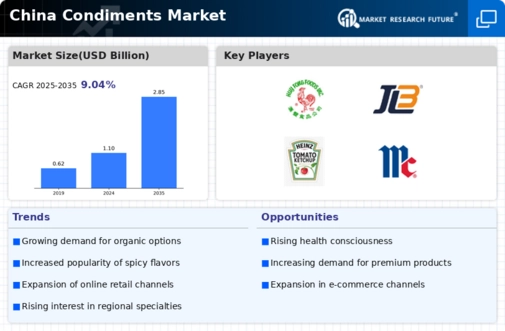E-commerce Growth
The expansion of e-commerce platforms in China significantly impacts the condiments market. With the increasing penetration of the internet and mobile devices, consumers are increasingly turning to online shopping for their grocery needs. In 2025, online sales of condiments are projected to account for over 30% of total sales, reflecting a shift in purchasing behavior. E-commerce provides consumers with access to a wider variety of products, including niche and specialty condiments that may not be available in traditional retail outlets. This trend is further supported by the convenience of home delivery services, which appeal to busy consumers. As e-commerce continues to grow, it is likely to reshape the distribution landscape of the condiments market, offering new opportunities for brands to reach their target audiences.
Culinary Innovation
Culinary innovation plays a crucial role in shaping the condiments market in China. The increasing interest in diverse cuisines encourages manufacturers to develop new and unique condiment offerings. This trend is evident in the rise of fusion sauces that blend traditional Chinese flavors with international influences. In 2025, the market for innovative condiments is expected to grow by approximately 15%, driven by consumer curiosity and the desire for novel taste experiences. Additionally, the introduction of premium and artisanal products is likely to attract discerning consumers willing to pay a premium for quality. As culinary creativity flourishes, the condiments market is poised to benefit from a broader array of products that cater to evolving tastes and preferences.
Rising Urbanization
The rapid urbanization in China is a pivotal driver for the condiments market. As more individuals migrate to urban areas, their lifestyles and eating habits evolve, leading to increased demand for convenience foods. Urban consumers often seek quick meal solutions, which frequently include various condiments. In 2025, urban areas are projected to house over 60% of China's population, significantly influencing consumption patterns. This demographic shift is likely to enhance the market for ready-to-use sauces and dressings, as busy lifestyles necessitate easy meal preparation. Furthermore, the growing number of restaurants and food service establishments in urban centers contributes to the expansion of the condiments market, as these venues require a diverse range of flavor enhancers to cater to consumer preferences.
Health and Wellness Trends
Health and wellness trends are becoming increasingly influential in the condiments market in China. As consumers become more health-conscious, there is a growing demand for condiments that align with healthier eating habits. This includes low-sodium, organic, and natural ingredient options. In 2025, it is anticipated that the market for health-oriented condiments will grow by approximately 20%, driven by consumer awareness of nutrition and wellness. Brands that offer healthier alternatives are likely to gain a competitive edge, as consumers actively seek products that contribute to their overall well-being. Furthermore, the incorporation of functional ingredients, such as probiotics and superfoods, into condiments may appeal to health-focused consumers. As the trend towards health and wellness continues, the condiments market is expected to adapt and innovate to meet these evolving consumer demands.
Cultural Heritage and Tradition
Cultural heritage and tradition significantly influence the condiments market in China. Traditional condiments, such as soy sauce, vinegar, and chili paste, remain staples in Chinese cuisine, reflecting the deep-rooted culinary practices of the nation. In 2025, the demand for authentic and traditional condiments is expected to remain strong, as consumers increasingly seek products that resonate with their cultural identity. This trend is likely to drive the growth of local brands that emphasize traditional recipes and production methods. Additionally, the resurgence of interest in home cooking, fueled by a desire to connect with cultural roots, may further enhance the market for traditional condiments. As consumers prioritize authenticity, the condiments market is expected to thrive on the rich culinary heritage of China.















Leave a Comment